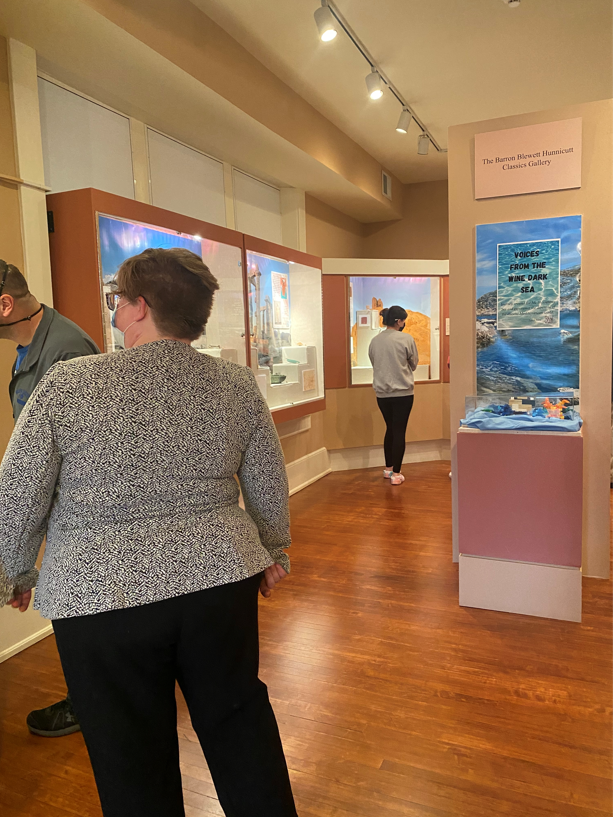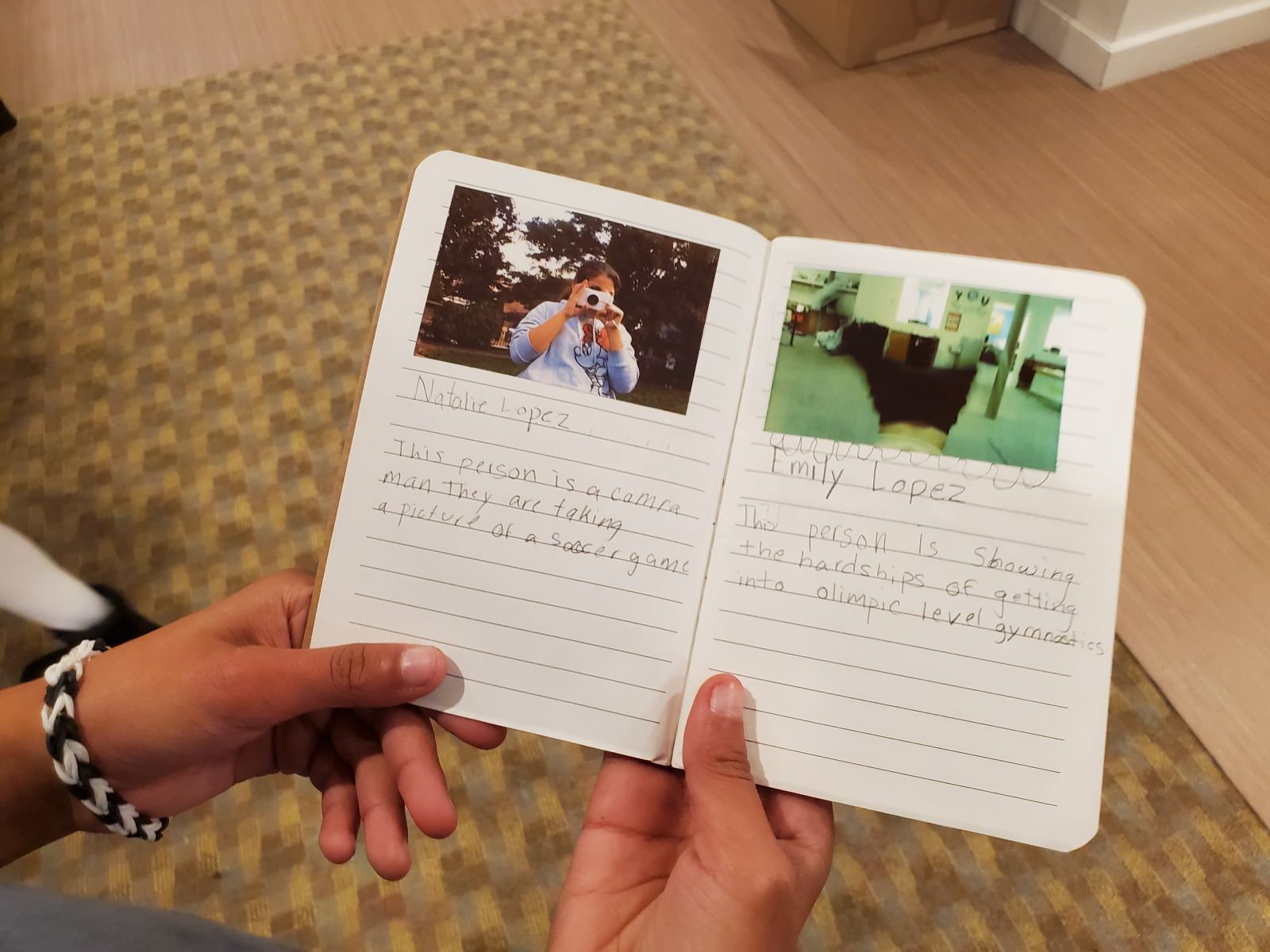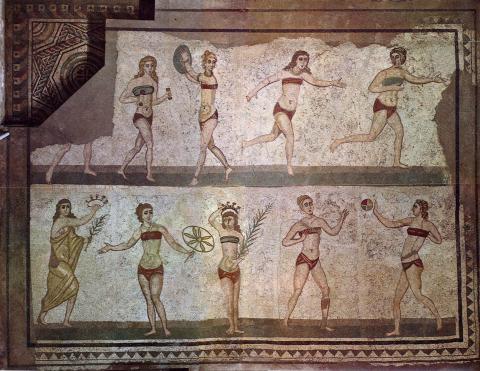Nina Papathanasopoulou
December 3, 2021
The Ancient Worlds, Modern Communities initiative (AnWoMoCo), launched by the SCS in 2019 as the Classics Everywhere initiative, supports projects that seek to engage broader publics — individuals, groups, and communities — in critical discussion of and creative expression related to the ancient Mediterranean, the global reception of Greek and Roman culture, and the history of teaching and scholarship in the field of classical studies. As part of this initiative, the SCS has funded 125 projects, ranging from school programming to reading groups, prison programs, public talks, digital projects, and collaborations with artists in theater, opera, music, dance, and the visual arts. To date, it has funded projects in 28 states and 11 countries, including Canada, the UK, Italy, Greece, Spain, Belgium, Ghana, Puerto Rico, Argentina, and India.
This post centers on three AnWoMoCo-funded projects: a music performance inspired by the myth of the ancient automaton Talos in San Francisco, California; an exhibition lifting up the voices of people all over the Mediterranean Sea in Chambersburg, Pennsylvania; and a project engaging girls with the history of women athletes in classical antiquity in Lowell, Massachusetts.
Talos Dreams
Ellie Falaris Ganelin, flutist and director of the Greek Chamber Music Project (GCMP), is organizing Talos Dreams: Chamber Music for the Future, a live performance of original instrumental music composed by Costas Dafnis, Professor of Technology and Applied Composition at the San Francisco Conservatory of Music, and inspired by the real and mythic automata of ancient Greece. The event celebrates the release of the new GCMP CD Synchronos: New Greek Voices and will take place live on December 8 at the Bowes Center, the San Francisco Conservatory of Music’s brand-new performance venue in the heart of San Francisco’s performing arts district. The event will also feature the premiere of Medea: Rebirth and Destruction, a new piece composed by students of the SF Conservatory of Music. You can register to attend in-person or virtually through this link.
Talos Dreams was commissioned by GCMP to create chamber music for the future by taking ancient stories and adapting them for current and future generations. Taking its inspiration from Talos, the mythic robot that guarded Crete against invaders, the work combines acoustic instruments (the piano, violin, flute, cello and oboe) with recorded electronic music to explore the concepts of made versus born, human versus inhuman. This mix of instruments and audio sources symbolically blurs the lines between what is considered natural and unnatural in music, creating a composition where live music is heard alongside the electronics, as if humans are playing together with robots.
Talos Dreams also features music performed on the “ghostplate,” a novel percussion instrument Dafnis built and designed with Bay Area improviser Tom Nunn. In a sort of reverse correspondence with Talos, who is artificial yet imitates a human, the ghostplate is acoustic, yet produces acoustic effects that sounds as though they are artificial – electronically synthesized — to the listener. Ganelin explains that “the ghostplate’s sonic palette — atmospheric, echoing, wispy, and metallic — sounds remarkably electronic for an acoustic instrument,” thus creating “a soundscape that is at once familiar and extraordinary.” An excerpt of the work, including ghostplate playing, can be seen in this video.
As Ganelin notes, Talos Dreams aims to create captivating music, spark the imagination, and facilitate a dialogue on some of the deeper universal questions about the role of technology in our lives. In Greek myth, mortals embrace technology to improve their lives but are often reminded of the risks that come with depending too much upon it. The stories of Prometheus and Icarus, for example, celebrate the advancement of technology while reminding us also of its dangers. Medea, a sorceress who can both end and reanimate life, proves to be Talos’ destroyer. Ganelin believes that “the stories we tell from ancient Greece are universal and stand the test of time. Creating art in response to these ancient stories has a broad appeal and offers something new and different in the modern day.”
The performance will be accompanied by a pre-recorded talk by Adrienne Mayor, a historian of ancient science and research scholar in the Department of Classics at Stanford University. Mayor’s recent book Gods and Robots: Myths, Machines, and Ancient Dreams of Technology focuses on the earliest concepts of automata, robots, and artificial intelligence that emerged in ancient Greece and helped inspire Talos Dreams.

Figure 1. The ensemble playing “Mechanism” from Talos Dreams in a music video. From left: Costas Dafnis, Ellie Falaris Ganelin, Ariel Wang, Lewis Patzner and Kyle Bruckmann. Photo credit: Ross Robinson. Courtesy: Greek Chamber Music Project.
Voices of the Wine-Dark Sea
Living in the rural town of Chambersburg, Pennsylvania, a 2–3 hour drive from the closest museum with an antiquities collection, Bonnie Rock-McCutcheon, Lecturer in Classics at Wilson College, decided to develop her college’s own underutilized antiquities collection and redesign its gallery in order to host a new exhibition titled “Voices of the Wine-Dark Sea.” The exhibition focuses on the everyday lives of people in the ancient world. It opened to the public in October 2021, at Barron C. Blewett Hunnicutt Classics Gallery.
Drawing on the nearly 500 items that were part of the college’s antiquities collection, Rock-McCutcheon worked with her students to organize the exhibition hall in the shape of a map of the Mediterranean Sea. Attendees peruse it as if sailing in the Mediterranean, traveling from place to place. As the title suggests, the exhibition focuses on lifting up the voices of people all over the Mediterranean, especially the voices of the marginalized. To do so, Rock-McCutcheon decided to juxtapose the objects on display with a primary literary text. For example, a section about Greece questions women’s traditional roles by relating women to warfare. An excerpt by Pausanias regarding the Argive leader and poetess, Telesilla, is juxtaposed with objects related to weaving and beautification that reflect traditional women’s roles, and with a bronze javelin and arrowhead that challenge those roles. The section on Egypt juxtaposes a letter of a girl to her father asking him to bring her fancy goods from the big city he is visiting with a precious little flask, a pair of gold earrings in the shape of Cupid, and a glass bracelet. QR codes are also added next to select objects for those interested in deepening their learning.
Along with designing and curating the exhibition, Rock-McCutcheon is also working on upgrading the storage structure for the artifacts, digitizing the collection, and creating programming for local schools and residents. Such programming will include tours of the exhibition; workshops for high-school students focusing on how to use primary sources and material objects in academic research; presentations for first-year seminars on polychromy in Greek sculpture; and workshops on gender, race, and class in the ancient world that provide hands-on experience with the objects in the exhibition.
Rock-McCutcheon feels she has an ethical obligation to the collection and wants to use it to raise the profile of Classics at her school and in the broader area:
Our goal is to create a resource that can serve our community and region by providing access to a collection from the ancient world and resources to help teachers integrate objects from the ancient world into their teaching. Part of our long-term plan is to make the collection accessible, essentially creating a local hub which can bring an informed, energized, and relevant ancient world to the community.

Figure 2. The entrance to the exhibition “Voices from the Wine-Dark Sea.” Photo by Bonnie Rock-McCutcheon.
Sports Garb/led: Ancient Mosaics and Their Relevance for Girls Today
In Massachusetts, the nonprofit organization Girls Inc. of Greater Lowell — an affiliate of Girls Inc., which provides enrichment programming for the empowerment of girls — received funding from AnWoMoCo to collaborate with PhotovoiceWorldwide, an innovative program that encourages discussion and change by putting cameras in the hands of people and encouraging them to think through a photo lens. The project, “Sports Garb/led: Ancient Mosaics and Their Relevance for Girls Today,” focused on women and sports in antiquity and consisted of a 4-week workshop culminating in an event held on October 26, 2021.
The event, for girls ages 10 and up, was run by visual artist Angela Lorenz. It centered on Roman mosaics of the 4th century CE that depict women competing in a pentathlon competition, holding weights for the long jump and a discus (see header image). The women in the mosaics wear what looks like a bikini and were traditionally interpreted dancers in costume, holding rattles and a tambourine. Outraged by the difficulty of people to think beyond women’s traditional roles and see these women as athletes, Lorenz created a modern adaptation of the mosaics titled Victorious Secret, intended to inspire conversation about the importance of women athletes in antiquity. Italian archaeologist Isabella Baldini Lippolis has played a key role in our understanding of the importance of female participation in the Roman pentathlon.
At the event, Lorenz discussed the work of Baldini Lippolis, her reasons for suggesting that these women were athletes, the barriers women have faced in competing in sports from antiquity to today, and her own work inspired by the mosaics. Lorenz organized numerous activities to complement her discussion, including puzzles of ancient athletes and light-box templates for tracing the iconography of the ancient pentathletes’ prizes and athletic equipment — the halteres (weights for the long jump), the trochus for the hoop race, and the palm leaf awarded to victors.
To prepare for the event, girls worked for 4 weeks with educator Stephanie Lloyd from PhotovoiceWorldwide to reflect on the mosaics’ history and to learn how to use photography as a vehicle to think about women and sports. They created a mini-exhibit of photos and related writing, including some Latin terminology and ancient graffiti from Pompeii and Herculaneum, which was displayed at the event. Meredith Munoz, Program Director of Girls Inc. of Greater Lowell comments further on their goals for this project:
The goal of this project is to engage girls in an underserved community and their families in interactive learning regarding the ancient world, and encourage interest in the ancient world, research, physical activity, and sports. By the end of the event and the photovoice pre-activity, we anticipate that girls will be inspired to relate to the experiences of young women in ancient times, be empowered to be critical and creative thinkers about visual representation and their interpretation, and empowered to participate in lifelong physical activity -- primary missions at Girls Inc.
The photos taken by the girls as part of this project will be featured in Lorenz’ upcoming book on these mosaics titled Sports Garb/led: The Case of Bikini-clad Pentathletes and Goals for Women from Ancient Rome to Title IX. As a result of this programming, Munoz and Executive Director Ashley Filipp hope to plan more multidisciplinary workshops regarding the role of women in the ancient world. They also anticipate that the project will inform a curriculum centered around the ancient mosaics, to be offered by Girls Inc. affiliates throughout the US and Canada, engaging girls in up to 80 underserved communities in interactive learning about the ancient world and young women’s experiences today.



Figures 3, 4, and 5. Samples of photos and journals girls made ahead of the October 26 event. Photos by PhotovoiceWorldwide.
Header Image: Roman Mosaic of Women Participating in a Pentathlon Competition. La Villa Romana di Piazza Armerina, room 26 (from G.V. Gentili 1999), Sicily, ca. 300 CE.
Authors


